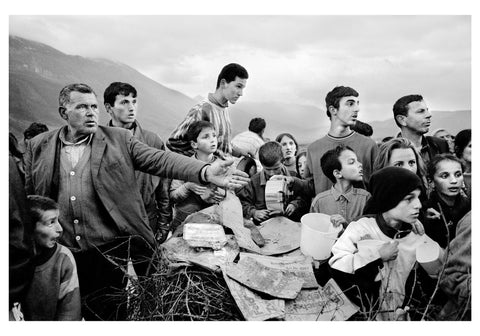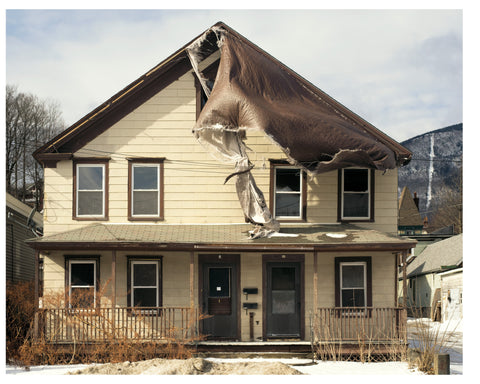 In the film Annihilation (2018), based on the novel by Jeff VanderMeer, director Alex Garland tells the story of a peculiar phenomenon that occurs in an undefined region of the United States. Following impact by a meteor, Area X is affected by a mysterious shimmer that swallows up increasingly vast portions of the surrounding countryside, threatening the entire world. A group of scientists enter the area to gather data and discover that the shimmer causes a series of mutations in organisms that come into contact with it, mingling the DNA of different types of life and species. A scene shows one of the female characters slowly turning into a plant and becoming lost in a garden of human-shrub hybrids. Her form is anthropomorphic, but her body has been entirely replaced by branches, leaves and flowers. Human and plant mingle inseparably, just as in Ghirri’s work which does not probe the two terms individually, but only their interconnection. Colazione sull’Erba is a subtle, geometric poem on the relationship between man and nature. It is a matter of reciprocal influences, relationships, symbioses and battles. Here man appears as a product of nature, upon which his very survival depends, while nature is symmetrically a product of man, who shapes it in his own image and likeness. The woman in Annihilation, immobilized (as in a photograph) by roots and transformed into an Arcimboldoesque figure, corresponds to the dozens of compositions of flowers and plants amassed by Ghirri in his series. Whether they are eccentrically pruned and meticulously aligned trees, gardens, flowerbeds or windowsills adorned with potted plants, these genuine botanical installations represent the reflection of their creator or owner. They are portraits that express the personality, tastes and fears of those who designed them. They are effective agents of individual distinction in the constructional paradigm of prefabs and blocks of flats that was invading the suburbs and provinces during those very same years that Ghirri was growing up and then working.
In the film Annihilation (2018), based on the novel by Jeff VanderMeer, director Alex Garland tells the story of a peculiar phenomenon that occurs in an undefined region of the United States. Following impact by a meteor, Area X is affected by a mysterious shimmer that swallows up increasingly vast portions of the surrounding countryside, threatening the entire world. A group of scientists enter the area to gather data and discover that the shimmer causes a series of mutations in organisms that come into contact with it, mingling the DNA of different types of life and species. A scene shows one of the female characters slowly turning into a plant and becoming lost in a garden of human-shrub hybrids. Her form is anthropomorphic, but her body has been entirely replaced by branches, leaves and flowers. Human and plant mingle inseparably, just as in Ghirri’s work which does not probe the two terms individually, but only their interconnection. Colazione sull’Erba is a subtle, geometric poem on the relationship between man and nature. It is a matter of reciprocal influences, relationships, symbioses and battles. Here man appears as a product of nature, upon which his very survival depends, while nature is symmetrically a product of man, who shapes it in his own image and likeness. The woman in Annihilation, immobilized (as in a photograph) by roots and transformed into an Arcimboldoesque figure, corresponds to the dozens of compositions of flowers and plants amassed by Ghirri in his series. Whether they are eccentrically pruned and meticulously aligned trees, gardens, flowerbeds or windowsills adorned with potted plants, these genuine botanical installations represent the reflection of their creator or owner. They are portraits that express the personality, tastes and fears of those who designed them. They are effective agents of individual distinction in the constructional paradigm of prefabs and blocks of flats that was invading the suburbs and provinces during those very same years that Ghirri was growing up and then working.
However, the parallel between man and nature goes further, for these arrangements are also representations of the second term of the dichotomy. Instead of painting a bucolic scene or hanging a painting or photograph of the same genre on the wall, we operate directly on the living body of nature, transforming it into a reproduction of itself. Reality and representation merge, according to a logic favoured by Ghirri, who spent much of his artistic career investigating the complex relationship between the tangible world and its image from every possible angle. The copy confuses us: it seems more authentic than the original. The plant growing in a pot ends up dimming the memory – direct or indirect – of the original environment, replacing it with a surrogate of itself without any awareness of the enormous gap between the two. It is virtual nature. On his way home from a trip to Sorrento for work in December 1986, Ghirri wrote: “The inside of the car that we’re travelling in, an Espace, is lit by the greenish lights of the stereo, of the controls, of the digital quartz instrument panel; the large window allows for breathtaking, cinematographic views... I get the impression that behind what I see there is another landscape, one which is the true landscape, but I can’t say what it is, nor can I imagine it. From the loudspeakers, the car radio has started to play the Blade Runner soundtrack, and the music is strangely in keeping with what I see... On the road home, I think how the gap that separates our visions from those of science fiction is slim, and how science-fiction narratives are no longer possible because the differences have become so slight, they are virtually irrelevant. In fact, I feel that all science fiction narratives have been realised, and the mutations, great and small, inside and outside of us, have already taken place without us even noticing it.”1 In 1986, when Ghirri was travelling in the Espace, Derek Jarman discovered that he was HIV-positive. It spurred him to create a garden at his cottage in Dungeness, seeking stimulation and consolation in nature. The result is a surreal, exotic oasis on the southern coast of England, which is both a work of art originating from a daily performance and a temple of secular transcendence. He dedicated an entire diary to this experience, writing: “I was describing the garden to Maggi Hambling at a gallery opening. And said I intended to write a book about it. She said: ‘Oh, you’ve finally discovered nature, Derek’. ‘I don’t think it’s really quite like that’, I said, thinking of Constable and Samuel Palmer’s Kent. ‘Ah, I understand completely. You’ve discovered modern nature’.”2 In scientific terms, a similar viewpoint led to the definition, during the same period, of what has become the recurrent notion of the Anthropocene. The “wilderness” no longer exists and is found only in history and ecology books. It has been ousted by an environment that is structurally, biologically and climatically determined by human activity. In our case, the mere action of representing is sufficient to transform nature into something else completely. “Ours is always a moderated view of nature,” Christy Lange wrote, “and any representation of it will always be a constructed landscape”.3 Ghirri insists on this point, commencing with the title of his project, which is obviously inspired by Édouard Manet’s painting of the same title (Le déjeuner sur l’herbe), clarifying that nothing encountered in the series is nature, but always just his own analogical interpretation of it, which depends on the creator’s choices and the technique used. Then, with respect to the French painter, he adds that he no longer represents nature but a series of samples of anthropized and altered “modern nature”. His photographs are representations of representations. Alterations of alterations. Copies of other copies.
In 1986, when Ghirri was travelling in the Espace, Derek Jarman discovered that he was HIV-positive. It spurred him to create a garden at his cottage in Dungeness, seeking stimulation and consolation in nature. The result is a surreal, exotic oasis on the southern coast of England, which is both a work of art originating from a daily performance and a temple of secular transcendence. He dedicated an entire diary to this experience, writing: “I was describing the garden to Maggi Hambling at a gallery opening. And said I intended to write a book about it. She said: ‘Oh, you’ve finally discovered nature, Derek’. ‘I don’t think it’s really quite like that’, I said, thinking of Constable and Samuel Palmer’s Kent. ‘Ah, I understand completely. You’ve discovered modern nature’.”2 In scientific terms, a similar viewpoint led to the definition, during the same period, of what has become the recurrent notion of the Anthropocene. The “wilderness” no longer exists and is found only in history and ecology books. It has been ousted by an environment that is structurally, biologically and climatically determined by human activity. In our case, the mere action of representing is sufficient to transform nature into something else completely. “Ours is always a moderated view of nature,” Christy Lange wrote, “and any representation of it will always be a constructed landscape”.3 Ghirri insists on this point, commencing with the title of his project, which is obviously inspired by Édouard Manet’s painting of the same title (Le déjeuner sur l’herbe), clarifying that nothing encountered in the series is nature, but always just his own analogical interpretation of it, which depends on the creator’s choices and the technique used. Then, with respect to the French painter, he adds that he no longer represents nature but a series of samples of anthropized and altered “modern nature”. His photographs are representations of representations. Alterations of alterations. Copies of other copies.
Ghirri overlaps layers of mediation and meaning, but without creating any sense of detachment from his subjects. Indeed, the exact opposite can be perceived in his images: an intimate affinity with each testimony of the man-nature combination that he manages to capture. After all, he carefully selects these expressions, concentrating exclusively on scenes that are apparently more marginal, fragile, simple and common. He is not interested in extreme cases or declarations of power (of man over nature, nature over man, man over other men), but in the spontaneous vegetation that grows out of the cracks in a wall or a pavement, and the deep, irrepressible urge that drives an ordinary individual from an ordinary town to rebuild a piece of paradise in their private space. Ghirri takes care of these little commonplace gestures exactly as their creators do with their miniature woods, prairies and jungles. His photographs are an act of fondness and sharing: this is his world. It is the world in which Ghirri was born and always lived; that of his memory and his present. Schama wrote, “The designation of the suburban yard as the cure for the afflictions of city life marks the greensward as a remnant of the old pastoral dream, even though its goatherds and threshers have been replaced by tanks of pesticide and industrial strength mowing machines”.4 The Emilian landscape is made up of pastel-coloured walls, gates that squarely divide the properties, balconies, garages, doors and garden gnomes. Notes:
Notes:
1. Luigi Ghirri, “L’obiettivo nella visione”, in Lotus International, n. 52, 1987, p. 134.
2. Derek Jarman, Modern Nature: The Journals of Derek Jarman, Vintage Books, London 1992, p. 8.
3. Christy Lange, “This Is Not a Landscape”, in Thomas Demand (ed.), La Carte d’après Nature, Nouveau Musée National de Monaco and MACK, Monaco and London 2010, p. 10. This book and the associated exhibition featuring works by many historical and contemporary artists also present a wide selection of photographs by Luigi Ghirri.
4. Simon Schama, Landscape and Memory, Vintage Books, London 1995, p. 16.
Excerpt from "The Geometric Chaos of Nature" by Francesco Zanot, from Colazione sull'Erba by Luigi Ghirri, published May 2019.






